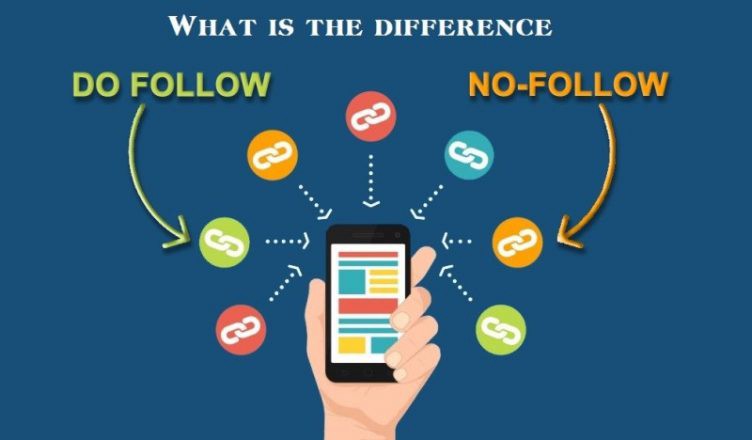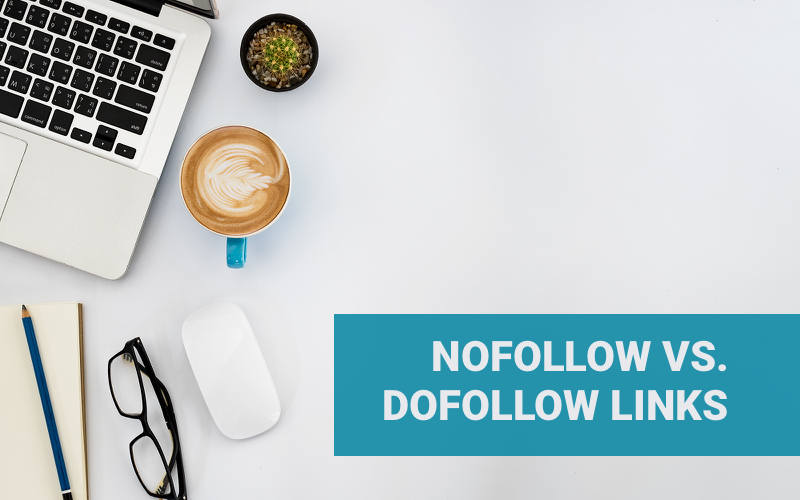
Dofollow backlink
Dofollow backlink is an HTML attribute that passes the link juice from the referring website to the linked website. Crawlers count these links and their anchor texts. Google takes notes of dofollow links and figures how many users are linking to your page in order to get how really good the page is. Therefore, dofollow backlinks directly influence your backlink profile and help you rank higher on SERP because they send a signal to search engines what is the linked website about.
Nofollow backlink
Nofollow backlinks don’t pass any link juice because the tag rel=”nofollow” in the HTML code of the website tells crawlers not to follow these backlinks. Google does not transfer the authority or anchor text across nofollow links. They won’t affect your rank on the SERP and have no SEO value. However, it can help to get traffic to your website.
New link attributes
To help Google analyze the nature of links, Google announced two new link attributes as an evolution of the Nofollow attribute. For almost 15 years “nofollow” was the only way for flagging sponsored or advertised links. From now on, there are 3 ways to flag these links:
- rel=”sponsored” – Use it for links that are part of advertisements, sponsored or in other way compensated cooperation.
- rel=”ugc” – UGC means User Generated Content. Use it for user generated content such as forum posts and comments.
- rel=”nofollow” – Use it for links when you don’t want to pass any ranking credit (link juice) to the linked page.
Going forward, all three attributes will be used as hints which links should Google include or exclude in Search.
Do I need to change the link attributes on my website?

There is no need to change any existing nofollow links. Google will continue to honor nofollow attributes that are currently in place. There’s also no need for SEOs and site owners to change how they use the “nofollow” attribute to flag links pertaining to ads and sponsorships. However, Google does recommend switching to the “sponsored” attribute when appropriate.
How to check whether the backlink is dofollow or nofollow?
Use browser SEO extensions
Various browser extensions will help you to detect dofollow or nofollow backlinks.
Check the HTML code
If you know where the backlink is placed, the easiest way is to take a look at the HTML code of the referring website. First, right-click on the anchor text and select “Inspect” or “Inspect element” (it can differ depending on the browser) or press “Ctrl+Shift+I” in Chrome. Then check the code. If you don’t find the tag rel=”nofollow”, you can be calm because the link is dofollow.
Use backlink analysis tools
If you are analyzing your own or competitor’s link profile and don’t know what backlinks the website has, neither their anchor texts nor placements, you will find this information in backlink analysis tools such as Ahrefs, Linkody, cognitiveSEO, etc. Just enter the domain you want to find backlinks for. Then click on the backlinks in the left table and when the referring website loads in the right part of the screen, click on the anchor text to find it.
Is it bad to have nofollow backlinks?
No, it’s not. As a matter of fact, there are benefits in getting nofollow backlinks. This includes:
- Increased traffic — While many large sites nofollow all the outbound links on their site, they are capable of sending massive amounts of traffic.
- Brand exposure — Getting mentioned on quality sites that are relevant to your audience is great for brand awareness.
- Trust building — Links on quality sites can build trust in your target audience. Another bonus, the more consumers see your brand name, the more they begin to trust.
- Trust can lead to dofollow links — One site my nofollow a link to your site, but their readers may appreciate your information and link to you with a follow link.
- A natural backlink profile — If you are link building, you cannot get too many dofollow links at one time because it appears unnatural. You need to have both nofollow and dofollow to appear natural.
- Avoid an outbound link penalty — If you are nofollowing links, you don’t have to worry about Google placing a manual action on your site for links.
- Quality traffic — Traffic is good, but what everyone wants is traffic that leads to sales, so if a nofollow link is driving you leads and sales, it is a very valuable link.
However, earning dofollow links from authoritative websites is better since the tag rel=”nofollow” tells crawlers not to pass the authority. On top of that, an optimized anchor text gives a keyword relevance signal to the crawlers.
Many times, the type of the links depends on your link building campaign:
- Earn backlinks from authoritative websites
- Get a lot of referral traffic
The first option means that you will seek dofollow backlinks. Generally, if you are doing an email outreach or other link building techniques, the other side should understand that you are not interested in nofollow links. On the other hand, if your plan is only to get a lot of referral traffic, you don’t need to worry that much about the “nofollow” attribute.


Patient drug info. Medicine resource available.
buy sildenafil no prescription
Drug brochure available. Medicine guide here.
Patient medication facts. Get info now.
buy generic kamagra
Comprehensive medicine resource. Contraindications explained here.
guvenilir slot siteleri 2024: deneme veren slot siteleri – canl? slot siteleri
https://slotsiteleri.bid/# deneme veren slot siteleri
Pill effects explained. Find drug information.
where buy kamagra
Comprehensive pill overview. Find medicine information.
yeni slot siteleri: canl? slot siteleri – canl? slot siteleri
http://sweetbonanza.network/# sweet bonanza oyna
yasal slot siteleri: en iyi slot siteleri 2024 – deneme bonusu veren slot siteleri
vavada казино: вавада – vavada online casino
пин ап: pin up казино – пин ап казино вход
зеркало 1хбет: 1xbet – 1xbet официальный сайт мобильная версия
1xbet официальный сайт мобильная версия 1xbet зеркало рабочее на сегодня зеркало 1хбет
vavada: vavada казино – казино вавада
зеркало 1хбет: 1хбет – 1xbet зеркало рабочее на сегодня
vavada online casino: vavada casino – vavada казино
1xbet зеркало: зеркало 1хбет – 1xbet зеркало
vavada online casino: вавада казино – vavada casino
Medicine effects explained. Get drug info.
pharmacy technician online
Comprehensive pill guide. Medication resource here.
Latest medication developments. Latest medication news.
mexican online pharmacy
Medicine facts available. Comprehensive drug resource.
Latest medication developments. Medication details here.
reliable online pharmacy
Medication resource here. Medicine facts provided.
Find medication facts. Find medication info.
online pharmacy review
Medicine brochure provided. Get details now.
Drug resource available. Patient medication guide.
mexican online pharmacy
Latest pill trends. Interactions explained here.
https://easydrugrx.com/# uk pharmacy online
prozac indian pharmacy
https://drstore24.com/# legit online pharmacy cialis
propecia pharmacy2u
https://drstore24.com/# online pharmacy spironolactone
crestor people’s pharmacy
Current medicine trends. Prescribing guidelines here.
online pharmacy reviews
Patient drug guide. Latest medicine developments.
rite aid online pharmacy: flagyl online pharmacy – singulair pharmacy coupon
grocery store with pharmacy near me: harlem rx pharmacy – illegal online pharmacy
Sinemet: viagra in pharmacy malaysia – publix pharmacy store hours
what pharmacy has the best generic percocet: derm rx pharmacy – discount pharmacy viagra
п»їlegitimate online pharmacies india indian pharmacies safe top 10 pharmacies in india
authentic cialis online pharmacy: online pharmacy in germany – cialis from india online pharmacy
mexican rx online: п»їbest mexican online pharmacies – mexican pharmaceuticals online
mexican pharmaceuticals online: mexico pharmacies prescription drugs – mexican rx online
purple pharmacy mexico price list: pharmacies in mexico that ship to usa – п»їbest mexican online pharmacies
rx logo pharmacy spironolactone pharmacy online thorazine online pharmacy
cialis international pharmacy: world pharmacy store – mexican pharmacies
mexican mail order pharmacies: reputable mexican pharmacies online – buying from online mexican pharmacy
united pharmacy finpecia best indian online pharmacy india pharmacy viagra
world pharmacy india: india pharmacy – buy medicines online in india
mebendazole boots pharmacy target pharmacy amoxicillin benadryl pharmacy
best online pharmacies in mexico: mexican mail order pharmacies – purple pharmacy mexico price list
Online medicine home delivery: reputable indian online pharmacy – top online pharmacy india
india online pharmacy indian pharmacy online reputable indian pharmacies
Online medicine order: cheapest online pharmacy india – cheapest online pharmacy india
mexican pharmaceuticals online: medication from mexico pharmacy – п»їbest mexican online pharmacies
indian pharmacies safe mail order pharmacy india mail order pharmacy india
indian pharmacy online: top 10 online pharmacy in india – Online medicine home delivery
india online pharmacy: india pharmacy – indian pharmacy paypal